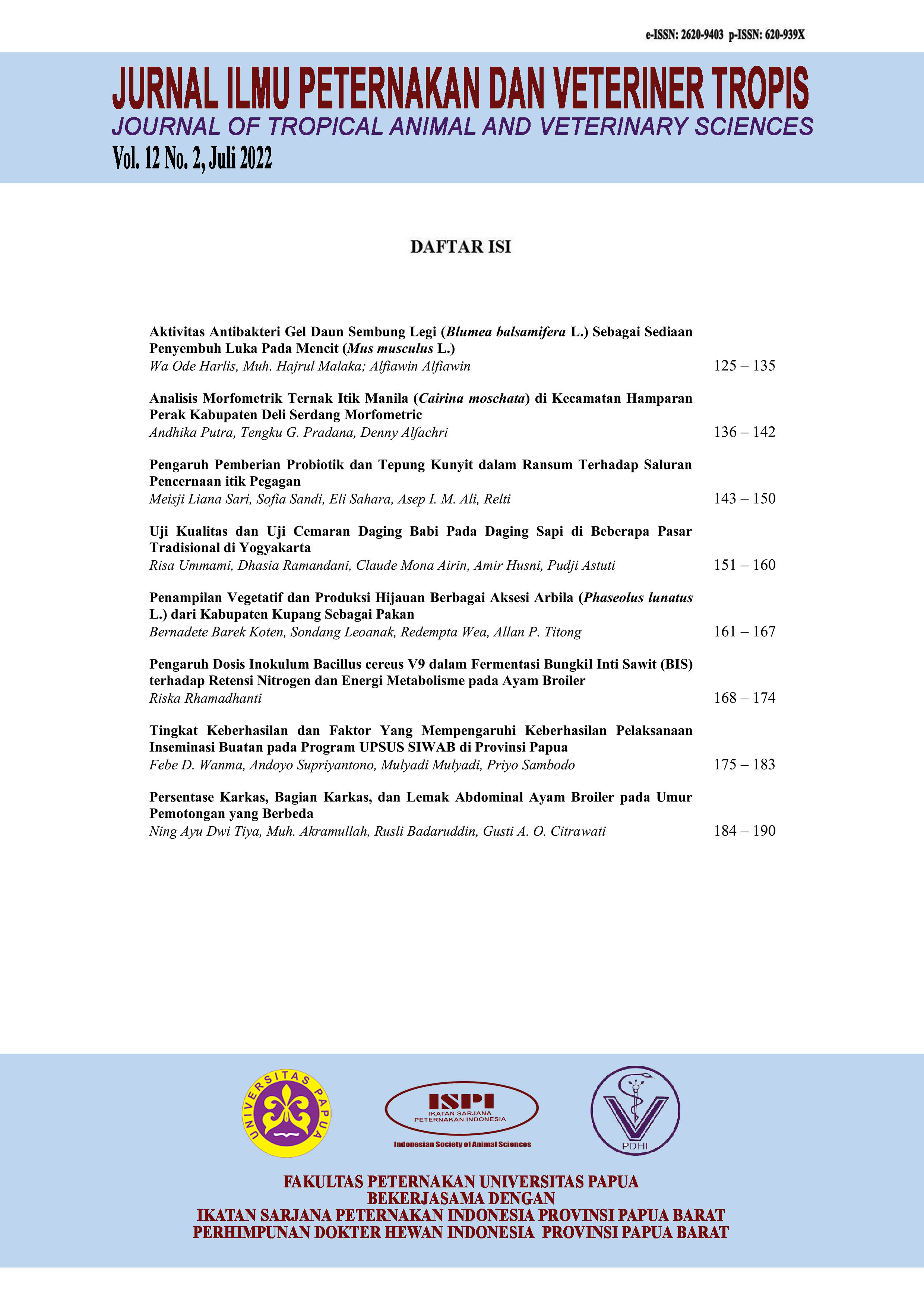Uji Kualitas dan Uji Cemaran Daging Babi Pada Daging Sapi di Beberapa Pasar Tradisional di Yogyakarta
Pork Detection Test And Meat Physical Quality In Some Traditional Markets From Yogyakarta
DOI:
https://doi.org/10.46549/jipvet.v12i2.277Keywords:
ELISA, meat physical quality, Pork adulteration, Rapid Pork Detection, Campuran babi, Kualitas fisik dagingAbstract
Abstract
Halal food is an essential thing to be considered by the Muslim community in Indonesia. Halal food must be free from pork, both as a primary ingredient and in the manufacturing process. Halal problems arise when there is a process of mixing meat or lard (adulteration) in halal animal meat for economic purposes. This study aims to identify the authenticity of beef circulating in several traditional markets in Yogyakarta using the Rapid Pork Detection Test and Enzyme-Linked Immunosorbent Assay (ELISA) detection methods. There were 10 samples of beef from several traditional markets in Yogyakarta. The tests carried out were organoleptic tests, Rapid Tests, and ELISA tests. The Rapid Pork Detection Test used is a special Rapid Test for detection of Xema® brand pork produced by PT. Indo Techno Plus. Sampling was carried out from May to June, the markets visited for sampling were the Pingit, Kranggan, Demangan, Ngasem, Godean, Sleman, Gamping, Mangiran and Sentul markets. The organoleptic examination includes odor, color, consistency, and pH. The results of the physical quality test of the meat showed that the beef circulating in the ten markets had a distinctive beef smell, red and pale red, had a chewy consistency that did not break down easily, and had a pH of 5 to 6 except for one sample (P9) from Sentul Market. The results of the Rapid Pork Detection Test showed a negative (-) pork content for all the beef samples. Meanwhile, in the ELISA test, there were three samples with positive results containing pork. The quality of beef circulating in these markets is within the normal range of meat quality and is safe for consumption.
Keywords: Pork adulteration; Rapid Pork Detection; ELISA; meat physical quality.
Abstrak
Makanan halal merupakan suatu hal yang sangat penting untuk diperhatikan oleh masyarakat muslim di Indonesia. Makanan halal harus terbebas dari kandungan babi baik sebagai bahan dasar maupun dalam proses pembuatannya. Permasalahan kehalalan timbul ketika terdapat proses pencampuran daging atau lemak babi (adulterasi) pada daging hewan halal untuk tujuan ekonomis. Penelitian ini bertujuan untuk mengidentifikasi keaslian daging sapi yang beredar di beberapa pasar tradisional di Yogyakarta menggunakan metode deteksi Rapid Pork Detection Test dan Enzyme Linked Immunosorbent Assay (ELISA). Sampel berjumlah sebanyak 10 sampel daging sapi dari beberapa pasar tradisional di Yogyakarta. Uji yang dilakuan adalah uji organoleptik, uji Rapid Test dan uji ELISA. Rapid Pork Detection Test yang digunakan adalah Rapid Test khusus deteksi daging babi merk Xema® produksi PT. Indo Tekhno Plus. Sampling dilakukan pada bulan Mei sampai dengan Juni, pasar yang di kunjungi untuk pengambilan sampel adalah pasar Pingit, Kranggan, Demangan, Ngasem, Godean, Sleman, Gamping, Mangiran dan Sentul. Pemeriksaan organoleptik meliputi bau, warna, konsistensi dan pH. Hasil uji kualitas fisik daging menunjukkan bahwa daging sapi yang beredar di sepuluh pasar tersebut memiliki bau khas daging sapi, berwarna merah dan merah pucat, memiliki konsistensi kenyal tidak mudah terurai, dan memiliki pH 5 sampai dengan 6 kecuali satu sampel (P9) dari Pasar Sentul. Hasil uji Rapid Pork Detection Test menunjukkan hasil negatif (-) kandungan daging babi untuk semua sampel daging sapi tersebut. Sedangkan pada uji ELISA terdapat satu sampel dengan hasil positif mengandung babi. Kualitas daging sapi yang beredar di pasar-pasar tersebut masih dalam kisaran kualitas daging normal dan aman untuk dikonsumsi. Uji cemaran daging babi dapat dilakukan dengan menggunakan metode ELISA karena memiliki tingkat sensitivitas yang lebih tinggi dibandingkan dengan pengujian rapid test
Kata kunci: Campuran babi; Rapid Pork Detection; ELISA; Kualitas fisik daging.
Downloads
References
Al-Kahtani HA, Ismail EA, dan Ahmed MA. 2017. “Pork detection in binary meat mixtures and some commercial food products using conventional and real-time PCR techniques”. Food chemistry 219: 54–60.
Anil MH, Love S, Helps CR, dan Habour DA. 2002. “Potential for carcass contamination with brain tissue following stunning and slaughter in cattle and sheep”. Food Control. 13, 431-436.
Anonim. 2009.”UU No. 18 Tahun 2009 Tentang Peternakan dan Kesehatan Hewan”. [Diacu 2021 Oktober 20] Tersedia pada:: //ditjenpkh.pertanian.go.id/userfiles/regulasi/85453cb4e07dc5422595300f5d9a890f.pdf.
Asensio L, Gonzales I, Garcia T dan Martin R. 2008. “Determination of Food Authenticity by Enzyme-Linked Immunosorbent Assay (ELISA)”. Journal Food Control. 19:1-8. doi:10.1016/j.foodcont.
Ballin NZ, Vogensen FK dan Karlsson AH. 2009. “Species determination – Can we detect and quantify meat adulteration?”. Meat Science 83: 165-174.
Cahyaningsari D, Latif H dan Sudarnika E. 2019. “Identifikasi Penambahan Daging Babi pada Pangan Berbahan Dasar Daging Sapi Menggunakan ELISA dan qPCR”. Acta Veterinaria Indonesiana, 7(2), hal.17-25. P-ISSN 2337-3202.
Cheng QF dan Sun DW. 2008. “Factors affecting the water holding capacity of red meat products: A review of recent research advances”. Crit. Rev. Food Sci. Nutr. 48, 137- 159.
Deni J dan Pardede MR. 2018. “Identifikasi pemalsuan daging babi pada daging dan bakso di Provinsi Banten” [internet]. [Diacu 2021 Oktober 20]. Tersedia pada: http://kesmavet.ditjenpkh.perta nian.go.id/index.php/berita/tuli san-ilmiahpopuler/207- pemalsuan-daging-banten.
Goldsby RA, Kindt TJ, Osborne BA dan Kuby J. 2003. “Enzyme linked immunosorbent assay. In Immunology. New York: W.H. Freeman & Company. hal. 148–150.
Husni P, Putriana NA dan Wicaksono IA. 2017. “Metode Deteksi Kandungan Babi dan Alkohol dalam Eksipien Farmasi dan Produk Obat untuk Menjamin Kehalalan Sediaan Obat, Majalah Farmasetika, Vol. 2 No. 1.
Kim M, Yoo I, Lee SY, Hong Y dan Kim HY. 2016. “Quantitative Detection of Pork in Commercial Meat Products by TaqMan Real-Time PCR Assay Targeting the Mitochondrial D-loop Region”. Food Chemistry 210: 102-106.
Kleinnijenhuis AJ, Van Holthoon FL dan Herregods G. 2018. “Validation and Theoritical Justification of an LC-MS Method for The Animal Species Specific Detection Of Gelatin”. Food Chemistry 243:461- 467.
Kuswandi B, Gani AA dan Ahmad M. 2017. “Immuno Strip Test for Detection of Pork Adulteration In Cooked Meatballs”. Food Bioscience 19: 1-6.
Menilinia S, Agung BA, Diyantoro dan Chrismanto D.. 2021. “Identifikasi Kandungan Komponen Babi pada Daging Curah dan Produk Olahan Daging Menggunakan Metode ELISA Sandwich di Balai Besar Veteriner Wates”. Jurnal Vitek Bidang Kedokteran Hewan Vol. 11 No. 2.
Nida L, Pisestyani H dan Basri C. 2020. “Studi Kasus : Pemalsuan Daging Sapi dengan Daging Babi Hutan di Kota Bogor”. Jurnal Kajian Veteriner, 8(2), hal.121-130. doi:10.35508/jkv.
Nurjuliana M, Che Man YB, Mat Hashim D dan Mohamed AKS. 2011. “Rapid Identification of Pork for Halal Authentication Using The Electronic Nose And Gas Chromatography Mass Spectrometer With Headspace Analyzer”. Meat Science 88: 638-644.
Ollong AR, Palulungan JA, Arizona R. 2020. “Analisis Jumlah Coliform dan Fecal Coli (MPN) Pada Daging Sapi dan Ayam di Kota Manokwari”. Jurnal Ilmu Peternakan dan Veteriner Tropis. Vol.10 N0.2. hal 113-118 .
Perestam AT, Fujisaki KK, Nava O, Hellberg RS. 2017. “Comparison of real-time PCR and ELISA-based methods for the detection of beef and pork in processed meat products”. Food Control 71: 346- 352.
Perkin Elmer. 2011. “Immunochromatography Diagram of Porcine Detection Kit” [internet]. [diacu 2021 Oktober 20]. Tersedia dari: http: //web.perkinelmer.com/porcine?gclid=CJvcuqmhl7YCFYR66wodxQsA2w.
Pestana EA, Belak S, Diallo A, Crowther JR, Viljoen GJ. 2010. “Early Rapid and Sensitive Veterinary Molecular Diagnostics Real-time PCR Application”. Dordrecht (DE): Springer Science & Bussiness Media.
Puspitasari R, Elfidasari D dan Perdana A. 2019. “Deteksi Kandungan Babi pada Makanan Berbahan Dasar Daging di Kampus Universitas Al Azhar Indonesia”. Jurnal Al-Azhar Indonesia Seri Sains Dan Teknologi, 5(2), 66–69.
Soares S, Amaral JS, Oliveira MBPP, Mafra I. 2013. “A SYBR Green real-time PCR assay to detect and quantify pork meat in processed poultry meat products”. Meat Science 94: 115-120.
Downloads
Published
How to Cite
Issue
Section
License
Copyright (c) 2022 Risa Ummami, Dhasia Ramandani, Claude Mona Airin, Amir Husni , Pudji Astuti

This work is licensed under a Creative Commons Attribution-NonCommercial-ShareAlike 4.0 International License.
License and Copyright Agreement
In submitting the manuscript to the journal, the authors certify that:
- They are authorized by their co-authors to enter into these arrangements.
- The work described has not been formally published before, except in the form of an abstract or as part of a published lecture, review, thesis, or overlay journal. Please also carefully read Jurnal Ilmu Peternakan dan Veteriner Tropis (Journal of Tropical Animal and Veterinary Science) Posting Your Article Policy at https://journal.fapetunipa.ac.id/index.php/JIPVET/publicationethics
- That it is not under consideration for publication elsewhere,
- That its publication has been approved by all the author(s) and by the responsible authorities “tacitly or explicitly“ of the institutes where the work has been carried out.
- They secure the right to reproduce any material that has already been published or copyrighted elsewhere.
- They agree to the following license and copyright agreement.
Copyright
Authors who publish with Jurnal Ilmu Peternakan dan Veteriner Tropis (Journal of Tropical Animal and Veterinary Science) agree to the following terms:
- Authors retain copyright and grant the journal right of first publication with the work simultaneously licensed under a Creative Commons Attribution License (CC BY-NC-SA 4.0) that allows others to share the work with an acknowledgment of the work's authorship and initial publication in this journal.
- Authors are able to enter into separate, additional contractual arrangements for the non-exclusive distribution of the journal's published version of the work (e.g., post it to an institutional repository or publish it in a book), with an acknowledgment of its initial publication in this journal.
- Authors are permitted and encouraged to post their work online (e.g., in institutional repositories or on their website) prior to and during the submission process, as it can lead to productive exchanges, as well as earlier and greater citation of published work.

This work is licensed under a Creative Commons Attribution-NonCommercial-ShareAlike 4.0 International License.





























.png)
